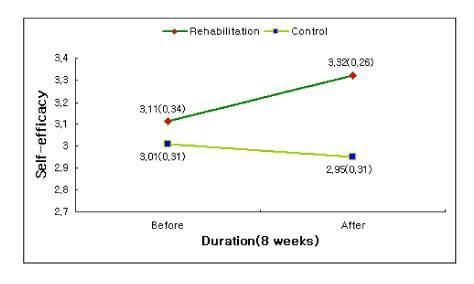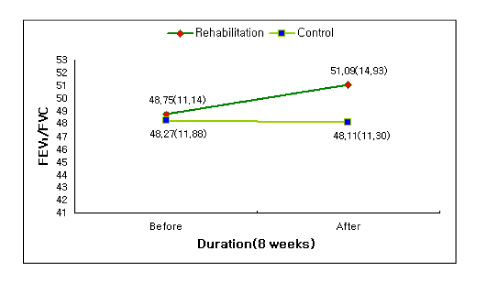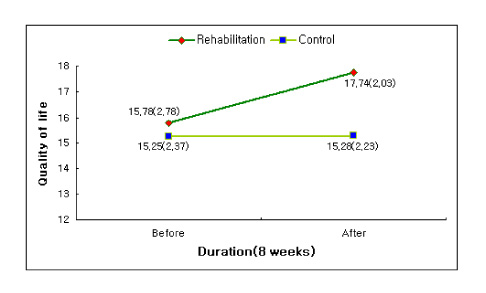Tuberc Respir Dis.
2006 Dec;61(6):533-546. 10.4046/trd.2006.61.6.533.
The Effects of Self-Efficacy Promoting Pulmonary Rehabilitation Program in Out-Patients with Chronic Obstructive Pulmonary Disease
- Affiliations
-
- 1Division of Nursing, Daedong College, Korea.
- 2Division of Social Welfare, Uiduk University, Kyungjoo, Korea. youpi88@hanmail.net
- KMID: 1970238
- DOI: http://doi.org/10.4046/trd.2006.61.6.533
Abstract
-
BACKGROUND: The aim of this study was to determine the effectiveness of self-efficacy promoting pulmonary rehabilitation in patients with chronic obstructive pulmonary disease (COPD).
METHODS
thirty six patients, with clinically stable COPD were randomly assigned: 18 to a rehabilitation group and another 18 as a control group, The subjects participated in a the self-efficacy promoting pulmonary rehabilitation program for 8 weeks. This program consisted of education, breathing retraining, exercise training, relaxation and counseling. The control group received education only. The outcome variables were self-efficacy, dyspnea, exercise endurance, pulmonary function, and quality of life. Dyspnea was measured using the modified Borg scale. Exercise endurance was measured by the six minute walking distance. The quality of life was measured by the quality of life index for pulmonary disease patients.
RESULTS
In the rehabilitation group after performing the self-efficacy promoting pulmonary rehabilitation program, the self-efficacy score, exercise endurance, and quality of life score were higher than the control group (p=0.007, p=0.038, and p=0.039, respectively). and the exertional dyspnea score was significantly lower than controls(p=0.045). However, the dyspnea score and FEV1 were similar after performing the self-efficacy promoting pulmonary rehabilitation program.
CONCLUSION
The self-efficacy promoting pulmonary rehabilitation program is effective to in improve self-efficacy, exertional dyspnea, exercise endurance and quality of life in patients with COPD.
MeSH Terms
Figure
Reference
-
1. Classification of disease 2002. Korea National Statistical Office. 2003. Available from: http://www.nso.go.kr.2. American Thoracic Society. Pulmonary rehabilitation-1999. Am J Respir Crit Care Med. 1999. 159:1666–1682.3. Wijkstra PJ, TenVergert EM, van Altena R, Otten V, Kraan J, Postma DS, et al. Long term benefits of rehabilitation at home on quality of life and exercise tolerance in patients with chronic obstructive pulmonary disease. Thorax. 1995. 50:824–828.4. Haggerty MC, Stockdale-Woolley R, ZuWallack R. Functional status in pulmonary rehabilitation participants. J Cardiopulm Rehabil. 1999. 19:35–42.5. American Association of Cardiovascular and Pulmonary Rehabilitation. Guidelines for pulmonary rehabilitation programs. 1998. 2nd ed. Champaign: Human Kinetics.6. American College of Chest Physicians/American Association of Cardiovascular and Pulmonary Rehabilitation. Pulmonary rehabilitation: joint ACCP/AACVPR evidence-based guidelines. Chest. 1997. 112:1363–1396.7. Bandura A. Self-efficacy: the exercise of control. 1997. New York: W. H. Freeman Company.8. Scherer YK, Schmieder LE, Schimmel S. The effects of education alone and in combination with pulmonary rehabilitation on self-efficacy on patient with COPD. Rehabil Nurs. 1998. 23:71–77.9. Cohen J. Statistical power analysis for behavioral science. 1998. New York: Academic Press.10. Wigal JK, Creer TL, Kotses H. The COPD self-efficacy scale. Chest. 1991. 99:1193–1196.11. Suh KH. A study on the relationship between respiratory disability and life satisfaction in patients with chronic obstructive pulmonary disease. 1988. Department of Nursing. Yonsei University;Master's Thesis.12. Borg GA. Psychophysical bases of perceived exertion. Med Sci Sports Exerc. 1982. 14:377–381.13. Ferrans CE, Powers MJ. Quality of life index: development and psychometric properties. ANS Adv Nurs Sci. 1985. 8:15–24.14. Park SJ. An explanatory model on quality of life for the patients with chronic obstructive pulmonary disease. 2001. Deptartment of Nursing. Yonsei University;Doctoral Thesis.15. Zimmerman BW, Brown ST, Bowman JM. A self-management program for chronic obstructive pulmonary disease: relationship to dyspnea and self-efficacy. Rehabil Nurs. 1996. 21:253–257.16. van der Bijl JJ, Shortridge-Baggett LM. The theory and measurement of the self-efficacy construct. Sch Inq Nurs Pract. 2001. 15:189–207.17. Covey MK, Larson JL, Wirtz SE, Berry JK, Pogue NJ, Alex CG, et al. High-intensity inspiratory muscle training in patients with chronic obstructive pulmonary disease and severely reduced function. J Cardiopulm Rehabil. 2001. 21:231–240.18. Hernandez MT, Rubio TM, Ruiz FO, Riera HS, Gil RS, Gomez JC. Result of a home-based training program for patients with COPD. Chest. 2000. 118:106–114.19. Larson JL, Covey MK, Wirtz SE, Berry JK, Alex CG, Langbein WE, et al. Cycle ergometer and inspiratory muscle training in chronic obstructive pulmonary disease. Am J Respir Crit Care Med. 1999. 160:500–507.20. Wijkstra PJ, van der Mark TW, Kraan J, van Altena R, Koeter GH, Postma DS. Effects of home rehabilitation on physical performance in patients with chronic obstructive pulmonary disease. Eur Respir J. 1996. 9:104–110.21. Leidy NK, Haase JE. Functional performance in people with chronic obstructive pulmonary disease: a qualitative analysis. ANS Adv Nurs Sci. 1996. 18:77–89.22. Reardon J, Awad E, Normandin E, Vale F, Clark B, ZuWallack RL. The effect of comprehensive outpatient pulmonary rehabilitation in dyspnea. Chest. 1994. 105:1046–1052.23. Wijkstra PJ, van der Mark TW, Kraan J, van Altena R, Koeter GH, Postma DS. Long-term effects of home rehabilitation on physical performance in chronic obstructive pulmonary disease [COPD]. Am J Respir Crit Care Med. 1996. 153:1234–1241.24. Scherer YK, Schmieder LE. The role of self-efficacy in assisting patients with chronic obstructive pulmonary disease to manage breathing difficulty. Clin Nurs Res. 1996. 5:343–355.25. Maltais F, LeBlanc P, Jobin J, Berube C, Bruneau J, Carrier L, et al. Intensity of training and physiologic adaptation in patients with chronic obstructive pulmonary disease. Am J Respir Crit Care Med. 1997. 155:555–561.26. Redelmeier DA, Bayoumi AM, Goldstein RS, Guyatt GH. Interpreting small differences in functional status; the six minute walk test in chronic lung disease patients. Am J Respir Crit Care Med. 1997. 155:1278–1282.27. Hui KP, Hewitt AB. A simple pulmonary rehabilitation program improves health outcomes and reduces hospital utilization in patient with COPD. Chest. 2003. 124:94–97.28. Wedzicha JA, Bestall JC, Garrod R, Garnham R, Paul EA, Jones PW. Ramdomized controlled trial of pulmonary rehabilitation in severe chronic obstructive pulmonary disease patients, stratified with the MRC dyspnoea scale. Eur Respir J. 1998. 12:363–369.29. de Torres JP, Pinto-Plata V, Ingentio E, Bagley P, Gray A, Berber R, et al. Power of outcomes measurements to detect significant changes in pulmonary rehabilitation of patients with COPD. Chest. 2002. 121:1092–1098.30. Jones PW, Baveystock CM, Littlejohns P. Relationships between general health measure with the sickness impact profile and respiratory symptom, psysiological measures, and mood in patient with chronic airflow limitation. Am Rev Respir Dis. 1989. 140:1538–1543.31. Bendstrup KE, Ingemann Jensen J, Holm S, Bengtsson B. Out-patient rehabilitation improves activities of daily living, quality of life and exercise tolerance in chronic obstructive pulmonary disease. Eur Respir J. 1997. 10:2801–2806.32. Weaver TE, Narsavage GL. Physiological and psychological variable related to functional status in chronic obstructive pulmonary disease. Nurs Res. 1992. 41:286–291.33. Belza B, Steele BG, Hunziker J, Lakshminaryan S, Holt L, Buchner DM. Correlates of physical activity in chronic obstructive pulmonary disease. Nurs Res. 2001. 50:195–202.34. Couser JI, Martinez FJ, Celli BR. Pulmonary rehabilitation that includes arm exercise reduces metabolic and ventilatory requirement for simple arm elevation. Chest. 1993. 103:37–41.35. Choe KH, Park YJ, Cho WK, Lim CM, Lee SD, Koh YS, et al. The effect of pulmonary rehabilitation in patients with chronic lung disease. Tuberc Respir Dis. 1996. 43:736–745.36. Mahler DA, Mackowiak JI. Evaluation of the short-form 36-item questionnaire to measure health-related quality of life measure health-related quality of life in patients with COPD. Chest. 1995. 107:1585–1589.37. Cambach W, Chadwick-Stravere RV, Wagenaar RC, van Keimpema AR, Kemper HC. The effect of a community-based pulmonary rehabilitation program on exercises tolerance and quality of life: a randomized controlled trial. Eur Respir J. 1997. 10:104–113.38. Behnke M, Taube C, Kirsten D, Lehnigk B, Jorres RA, Magnussen H. Home-based exercise is capable of preserving hospital-based improvements in severe chronic obstructive pulmonary disease. Respir Med. 2000. 94:1184–1191.
- Full Text Links
- Actions
-
Cited
- CITED
-
- Close
- Share
- Similar articles
-
- The Study on the Effects of a Respiratory Rehabilitation Program for COPD Patients
- Pulmonary Rehabilitation in Chronic Obstructive Pulmonary Disease (COPD)
- Development and Evaluation of Motivational Interviewing Pulmonary Rehabilitation Program Based on Self-Determination Theory for Patients with Chronic Obstructive Pulmonary Disease
- The Effects of a Pulmonary Rehabilitation Program for Chronic Obstructive Pulmonary Disease Patients
- Pulmonary Rehabilitation for Chronic Obstructive Pulmonary Disease: Highly Effective but Often Overlooked








